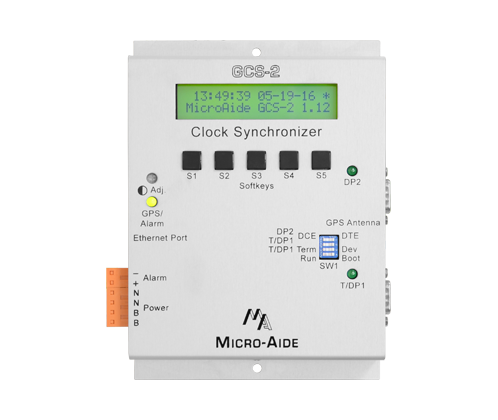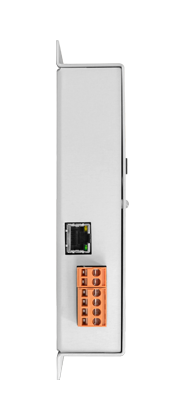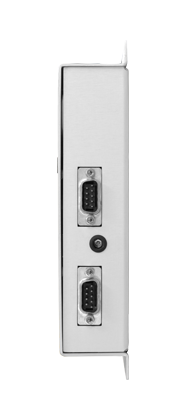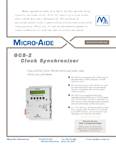On the Outside
Active Alarm LED
This LED flashes green to indicate GPS communications. It illuminates red to indicate a Target Device sync failure or loss of GPS sync.
Ethernet Port (opt.)
The Ethernet Port allows the device to be connected to a LAN. If a time server is accessible via the LAN it can be assigned as the precise time source.
GPS Receiver
Without user intervention, the device's real-time clock (RTC) is kept 100% accurate by means of the GPS Receiver. The receiver uses an external, ruggedized antenna. If not connected to a time server, the GPS Receiver is assigned as the precise time source.
Active Alarm Output
The Alarm Output is active when a Target Device sync failure or loss of GPS sync occurs.
BN Power
Typical battery power can be used to power the device. Its operating range is 10 to 36Vdc. The internal power supply is fully isolated.
40-Character LCD
The LCD and Keypad allow an onsite user to configure the device without using a PC. The Keypad switches are implemented as multifunction soft keys.
5-Position Keypad
The LCD and Keypad allow an onsite user to configure the device without using a PC. The Keypad switches are implemented as multifunction soft keys.
Mode Selection Switches
These switches control the run/boot mode of the device. The first port can be assigned as a Terminal Port or Device Port 1. The DCE/DTE appearance of the Device Ports is also assigned.
2 Device Port LEDs
Separate LEDs are used to indicate data activity on each of the ports.
Terminal/Device Port 1
The first port can be configured as a Terminal Port. When connected to a PC it allows the user to set up the device. Once setup has been completed, the same port can be re-configured as Device Port 1. Baud rates from 300 to 115,200 are supported.
Device Port 2
This port is connected to a Target Device. The port implements hardware handshaking. Baud rates from 300 to 115,200 are supported.
Small Mounting Footprint
The device can be easily mounted to a backboard with two screws.



GCS‑2 Documentation



On the Inside
Compatible with non-
MICRO‑AIDE Products
The GCS can sync the internal clock of an HCA, 216DL, EC‑5, HXP‑3, VHLC and Microlok II. MICRO‑AIDE is fully commited to expanding the list of compatible devices.
Supports MICRO‑AIDE Legacy Products
MICRO‑AIDE devices lacking a GPS Receiver or Ethernet Port option are fully compatible with the GCS.
Operates as a Time Server Device
The GCS maintains an accruate clock using its GPS Reciever. Using SNTP-Unicast and -Multicast protocols it serves as the source of accurate time to other LAN Target Devices. Concurrently, the GCS sends clock-set commands to Target Devices connected to its Device Ports. Unlike other time servers, the GCS is designed to be a ruggedized device as required by rail signal applications.
Operates as a Time Client Device
As a Time Client device the GCS receives accurate time from a LAN-accessible Time Server. The GCS sends clock-set commands to Target Devices connected to its Device Ports.
Sync Intervals are User-Defined
Target Devices can be synchronized at intervals of 1, 12 or 24 hours.
Go Command Performs Immediate Sync
After the setup procedure is completed the Go command can be used to sync all Target Devices without having to wait for the next sync interval.
Provides Remote Access to Target Devices
The Device Port Access Mode (DPAM) feature allows a remote user (requires Ethernet Port option) or local user to directly access a Target Device. The GCS operates in data transparent mode.
Digitally Signed Data Reports
The Digitally Signed Report Feature (DSRF) also uses DPAM to support remote and local user access to a Target Device. DSRF appends a digital signature to any Target Device report. This makes alteration of the report easily detectable.
Settings for all North American Time Zones
GPS and SNTP time are relative to UTC‑0. As part of the setup procedure, allowance for local time can be made by selecting the appropriate time zone.
Automatic Daylight Saving Adjustment
If enabled, an adjustment for Daylight Saving Time will be made twice per year.
Clock Accuracy ±8 sec. per Month (std.)
Even in the absence of clock synchronization the GCS's RTC is highly accurate. The clock will continue to run with a loss of power of up to 30 days duration.
Comprehensive Sync Performance Log
The Sync Log can be used to verifiy that the GCS had an accurate clock and that each Target Device was successfully synchronized.
